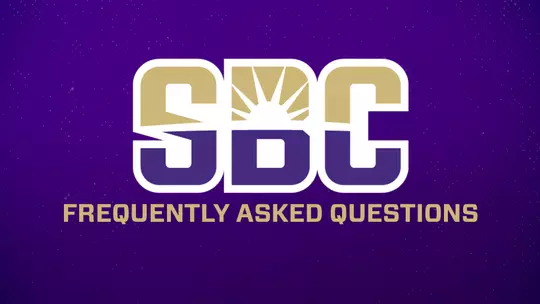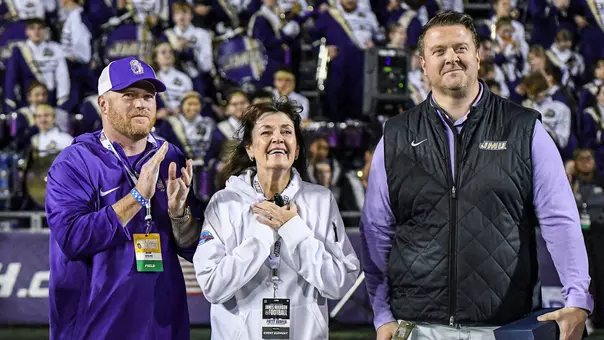
JMU to the Sun Belt: Frequently Asked Questions
11/6/2021
James Madison University announced on Saturday, November 6, 2021, that it will be joining the Sun Belt Conference and departing the Colonial Athletic Association.
Here are some frequently asked questions, as the Dukes prepare for transition into a new conference.

Why is this a good decision for James Madison University?
There are numerous benefits to the university by moving to the Sun Belt, but most significantly: 1) it allows JMU student-athletes across all sports to compete at the highest level; 2) it aligns JMU in a conference with institutional peers among a group of primarily large, public universities; 3) it offers the opportunity to build regional rivalries within a geographic footprint that also makes financial sense for the university; and 4) allows the athletics program to align with the university in national prominence with the expected transition to R2 (doctoral university – high research activity) status in the university’s Carnegie classification.
What schools are in the Sun Belt Conference?
Entering the 2021-2022 academic year, the Sun Belt consisted of all-sports members Appalachian State, Arkansas State, Coastal Carolina, Georgia Southern, Georgia State, Louisiana, Louisiana-Monroe, South Alabama, Texas State and Troy. Two additional current members, Little Rock and UT-Arlington, do not play football. Within the last few weeks, the Sun Belt has added JMU from the FCS along with three institutions from Conference USA (Marshall, Old Dominion and Southern Miss).
When will JMU officially join the Sun Belt?
No later than July 1, 2023. JMU is working with the Sun Belt to formalize the transition as early as possible.
Why are rivalries so important?
College sports were built on rivalries. Previous waves of realignment focused on other criteria, such as media market size. JMU and the Sun Belt share the philosophy that a return to an emphasis on regional play among similar institutions with passionate fan bases will reignite the sense of rivalry in college sports. This will boost overall fan interest, which leads to ticket sales and other support.
What does R2 status mean?
R2 is the second-highest designation granted by the Carnegie classification system for colleges and universities. It speaks to the overall scope of the university’s mission, particularly related to conferring of doctoral degrees and research activity. In short, the expected R2 transition elevates JMU from more of a regional university to national in its appeal. This is a perfect fit for the ability to compete in a conference of national interest, such as the Sun Belt.
Will JMU add women's sports in order to meet Title IX compliance?
No, a previous FBS feasibility study in 2013 declared that JMU was not required to add women’s sports. The department closely evaluates its Title IX compliance on a regular basis with the help of a national consultant. JMU is in good shape because it fully funds all of its sport programs in the areas of scholarships, coaching staffs and cost of attendance.
What is the Sun Belt's TV package, and is there media money distributed to the schools?
Due to the recent nature of the Sun Belt’s growth, exact financial figures are not available. However, JMU will earn a share of the conference’s television distribution, compared to a minimal distribution amount from the CAA’s agreement with FloSports. The Sun Belt is under contract with ESPN through 2030-2031.
Will JMU play on ESPN, FloSports or something else?
All live streams for all JMU sports will be on ESPN+ once the Dukes join the Sun Belt. FloSports will no longer carry any games, unless JMU were to play on the road at an institution that streams on FloSports. The Sun Belt’s TV package does include some games on a combination of ESPN, ESPN2 and ESPNU.
What is the Cox Bill, and why is it important for a conference change?
The Cox Bill, officially known as Virginia Code §23.1-1309, was passed in 2015 in order to regulate the amount of money that a state institution designates from student fees to pay for intercollegiate athletics. The law requires that universities have a sound financial plan in the event of a transition to a higher level and that they present that plan to a state commission (Intercollegiate Athletics Review Commission) before a conference change can be finalized. FCS schools must collect no more than 70% of revenue from student fees, while FBS Group of Five schools must fall under 55%. JMU presented its plan to the state commission on November 5, 2021. JMU is committed to controlling its student comprehensive fee in compliance with the parameters of the state legislation.
How long will it take JMU to fully transition to FBS?
Currently, the NCAA requires a two-year period for an institution to fully transition from FCS to FBS. The notification must occur by June 1, meaning that JMU’s transition would officially begin on July 1, 2022 and end on June 30, 2024. So JMU would be fully FBS, including bowl eligibility, for the 2024 football season. All other sports would be immediately eligible for postseason play upon joining the Sun Belt.
Will all sports move up a division or just football?
This can often be a misunderstanding in the public eye. JMU is already an NCAA Division I institution. The division is subdivided into three groups: FBS (Football Bowl Subdivision, or the highest level), FCS (Football Championship Subdivision) and institutions that do not sponsor football. All JMU sports continue to be Division I and can compete in the NCAA Championship for Division I as before. The football subdivision is the only change.
Is this just about football? Won't other sports be hurt?
The opportunity to compete in FBS football is certainly a significant change resulting from joining the Sun Belt. However, the benefits to the university are numerous, as outlined above. JMU evaluated the scenario for every sport by joining the Sun Belt, and, while the strength of each sport varies to some degree within the league, overall we are confident that JMU is equipped to compete for championships immediately in most sports.
Can JMU still compete for CAA championships the rest of this year?
JMU was extremely disappointed to learn, just prior to finalizing its agreement with the Sun Belt, that its sport programs would be prevented from competing for CAA Championships for the remainder of JMU’s membership in the CAA, beginning with the men’s soccer championship that JMU was scheduled to host. While a bylaw stating such has been on the conference’s books for many years, much has evolved in the overall landscape of intercollegiate athletics since that time. In an era emphasizing student-athlete welfare, this recent vote of the league’s presidents runs counter to such emphasis. Eight other Division I conferences currently contain full members that have officially declared they are moving to a different league. All eight conferences still allowed departing schools and their student-athletes to compete for that league’s championships this fall. By extension of the CAA’s decision, JMU will not host the four championships it was scheduled to host (men’s soccer, women’s basketball, lacrosse and softball). Additionally, the league elected to remove JMU from any conference games in its package of national men’s basketball broadcasts on CBS Sports Network. The CAA and its commissioner have been consistent and clear in promoting student-athletes as the focal point in all decision making – until this one. JMU made an impassioned plea to the CAA’s council of presidents arguing why it was justified and appropriate to allow JMU student-athletes to compete, but instead the league’s presidents made a self-serving decision for the sole benefit of their own institutions.
Hasn't JMU been part of the CAA for a long time?
JMU was a founding member of the CAA in 1985 and has proudly represented the league during many significant achievements, including four national championships and, most recently, in its run to the Women’s College World Series. However, it has become evident in recent years that a divide exists among the CAA’s current membership. The decision related to participation in conference championships is just one example that the composition of the CAA no longer matches the emphasis and ambition of JMU Athletics. Alternatively, the Sun Belt consists of large, public institutions invested in their student-athletes and in competing at the highest level while doing so with collegiality and shared vision.
Will JMU continue to schedule CAA schools moving forward?
Regionality will be a major emphasis as all JMU sport programs build non-conference schedules in the future. Each head coach will have the opportunity to build a non-conference schedule that best fits the needs of his or her program.
Did JMU complete a feasibility study about moving to FBS?
JMU did complete a feasibility study in 2013, which stated that the university was well-equipped to transition to the FBS level if it desired. The study also provided recommendations for such consideration, perhaps the most significant being the construction of a modern basketball facility. JMU achieved this recommendation with the building of the Atlantic Union Bank Center, which debuted in November of 2020.
Does the Sun Belt sponsor all 18 of JMU's sports?
Currently there are four sports at JMU that are not sponsored by the Sun Belt. However, the league anticipates adding men’s soccer as a result of the sports portfolio of its recent institutional additions. JMU expects to attain affiliate membership in another conference for the sports of lacrosse, field hockey and swimming & diving. JMU also adds one championship opportunity as the Sun Belt sponsors a championship meet in indoor track and field, which the CAA did not.

How long will it take JMU to be bowl eligible?
There is a two-year transition period to attain FBS status. So JMU’s first season of bowl eligibility would be the 2024 season.
Can JMU still be in the FCS playoffs this year?
Yes, 2021 will be JMU’s final year participating in the FCS playoffs.
Will JMU still play future games that were previously scheduled?
JMU is working through contractual implications of our future games, regarding both FBS and FCS opponents.
What will future schedules look like? Will JMU play Power 5 schools, other Group of 5 schools, or FCS schools?
Unlike the FCS, where the season could be 11 or 12 games depending upon the calendar, all FBS programs play 12 games in a season, followed by a conference championship game and a bowl game, if eligible and selected. During the transition period, fans can likely expect a combination of opponents from all three levels. Once JMU has fully transitioned to FBS status in 2024, current NCAA rules allow institutions to count one FCS opponent toward bowl eligibility. So JMU would play no more than one FCS opponent per season.
What are the divisions and how many conference games will there be?
The East division of the Sun Belt will include JMU, Appalachian State, Coastal Carolina, Georgia Southern, Georgia State, Marshall and Old Dominion. The league has not set future schedules resulting from realignment, however a likely scenario would be six games within the division, two games against the West division, one FCS opponent and three non-conference FBS opponents.
Are there more scholarships in FBS?
Yes, the FCS level allows 63 total football scholarships, which can be split among more than 63 student-athletes. The FBS level allows 85 scholarships, which are full scholarships to each student-athlete and not split. However, JMU’s overall squad size is not likely to change as it already compares well to FBS programs.
What is the difference between bowls (FBS) and a championship (FCS)?
The NCAA does not sponsor a championship in FBS football. Thus, the only NCAA Division I football national champion is the FCS champion. The College Football Playoff (CFP) governs the national championship system for the FBS level, which currently consists of four teams competing in semifinals and a championship in early January. There is discussion and consideration whether that number could increase in future seasons. Teams not selected for the CFP can be placed in postseason bowl games. These are typically arranged from predetermined tie-ins with various FBS conferences. The Sun Belt currently has five such preset opportunities for its football programs to reach a bowl game, with the opportunity to add more as the league expands. These games pit programs against other qualifying programs in other leagues, often in an attractive, neutral destination and with a monetary payout involved. One important distinction is that there is no payout system in FCS football. JMU can spend significant money in the FCS postseason over the course of hosting home games and advancing to the national championship in Frisco.
When will JMU expand the football stadium?
There is no current timeline to increase the capacity of Bridgeforth Stadium. Should ticket demand increase and JMU consistently sell out the stadium, expansion could be evaluated at a future date.

How will this impact the overall JMU Athletics budget?
Some operational costs will increase related to travel, scholarships, salaries and overall operations. However, JMU will also add new revenue lines in the form of distributions from the Sun Belt’s contract with ESPN and the College Football Playoff.
Will coaches' salaries go up or staff positions be added?
Some sports may see adjustments in coaching salaries in line with peer salary structures in the Sun Belt. FBS football does allow for three more coaching positions than in FCS football.
Will JMU have to pay a CAA exit fee and/or a Sun Belt entrance fee?
The exit fee from the CAA is $1 million. The Sun Belt agreed to waive its entrance fee.
How will fundraising for athletics be impacted?
Private support is critical to success at the FBS level. The cost of operation goes up, but so does the quality of competition. Over the years, many supporters have indicated that their contributions would increase if JMU played at the FBS level. Since this possibility was publicly announced, JMU has heard from a number of major donors that they will make significant contributions to support this transition. That support will be much appreciated if JMU is to not just belong but thrive as a member of the Sun Belt.
Will ticket prices go up?
JMU employs a built-in escalator system to control its ticket prices within a reasonable framework. Future ticket adjustments will fall within this pricing philosophy.
Will JMU still get paid to play guarantee football games?
Most Power Five programs do pay a guarantee to Group of Five programs for non-conference games. In fact, that rate is typically significantly larger than a guarantee paid to an FCS program. So, JMU’s ability to generate guarantee game revenue will hinge upon the number of Power Five road games that are scheduled in any given season.
Are there other facility needs?
The FBS feasibility study in 2013 identified a new basketball arena as a critical need to successfully transition to an FBS conference. Construction was recently completed on the Atlantic Union Bank Center, a state-of-the-art basketball and event facility. JMU continues to prioritize quality competition and training facilities for its student-athletes in all sports, thus several additional projects are already underway or in development. However, none of them are specifically related to the move to the Sun Belt.




